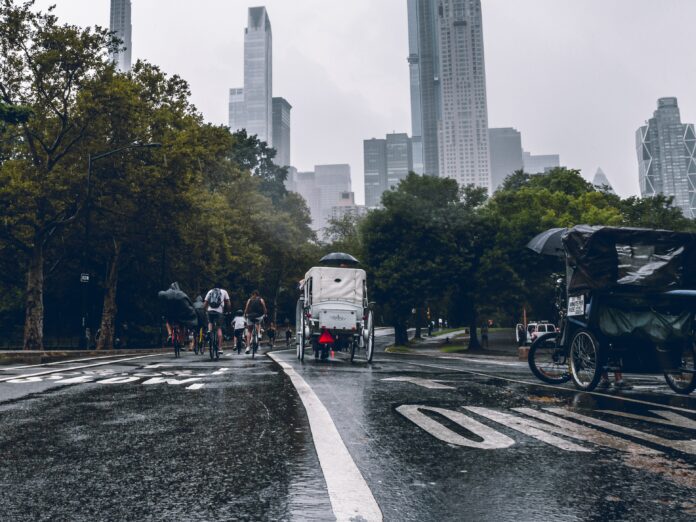The holiday season ushers in images of a snow-covered Central Park filled with footprints left from horse-drawn carriages on the winding paths of the iconic NYC park. But should the horses, and their carriages, be a staple in the scenery or just a distant memory, only living in stories and photos?
The battle for horse-drawn carriages in NYC’s Central Park intensified on February 29, 2020, when a short video went viral on Twitter. The video showed a 12-year-old mare named Aisha stumbling while struggling to remain afoot, then collapsing into a fence on the side of the road.
Meanwhile, a neat line of horse-powered buggies and their drivers waited patiently on the opposite side, looking to transport visitors on a sight-seeing tour of the iconic park — a tradition that has endured since 1858.
But this video and other images shot over the past few years are once again shining a light on one of the city’s most divisive issues: the future of horse-drawn carriages in Central Park.
The Battle for Central Park’s Horse-Led Carriages: TWU Vs. NYClass
This isn’t just a pitched battle between equestrian lovers and carriage drivers in Central Park, with former NYC Mayor Bill de Blasio caught in the middle. In fact, the central conflict lies between the workforce responsible for handling the horses and the organization that wishes to put an end to them.
The former is a group of horse enthusiasts that have joined the Transport Workers Union Local 100 (TWU). These are blue-collar workers who make a living by driving the horse-led carriages, grooming the equestrian fleet, and making sure that Central Park’s stables are adequate enough to house the gentle giants. Members of TWU are fighting arduously so that the horses can remain a mainstay of NYC’s history and culture.
On the other hand, New Yorkers for Clean, Livable, and Safe Streets (NYClass) is pushing just as hard to replace the carriages with electric buggies. They argue that the horses are overworked, mistreated, and malnourished while sporting harnesses and working in conditions that can injure or kill them.
A statement issued after publication of this article by Edita Birnkrant, Executive Director of NYCLASS states that “NYCLASS and every major animal welfare organization in the country [want] carriage horses permanently removed from city streets where they often spook in traffic, crash into vehicles or simply collapse on city streets, sometimes dropping dead and often resulting in injuries to people.” Birnkrant depicts the “cruelty and abuse of the carriage horses – sick horses [who] are routinely made to work, underweight horses with ribs sticking out, covered in open wounds, with painful and infected legs, lameness in legs, untreated diseases” that NYClass has been documenting to fight for the eradication of horse-drawn carriages.
In the past, members of TWU have refuted claims made by NYClass, assuring the general public that it complies with stringent carriage industry regulations imposed on them by five agencies in NYC, two of which are the city’s Health Department and the NYPD. These regulations are directed at ensuring that the horses are treated fairly and ethically. They include but are not limited to:
- Ensuring that each horse gets five weeks of vacation time on a farm each year.
- Providing routine medical care such as vaccinations, as well as dental care.
- Keeping the horses boarded during freezing temperatures or scorching heat.
- Providing spacious accommodations at the stables so that the horses can lie down comfortably.
Based on these regulations, TWU insists that its treatment of the animals is humane enough to warrant pushing back against any move to replace the horse-powered carriages with electric buggies.
Central Park’s Horses: A Question of Ethics
On the issue of the horse that went viral, a spokesperson for Central Park’s carriage industry issued a statement citing a genetic disease as the reason behind Aisha’s sudden, harrowing collapse and subsequent death that sparked controversy and vigils honoring her legacy.
The veterinarians who individually examined Aisha post-mortem, Dr. Camilo Sierra and Dr. Dennis Farrell, both concluded that the death was due to a genetic condition called PSSM. Dr. Sierra even went on to say that she found the horse in good condition with no signs of abuse or mishandling.
However, Dr. Eileen Jefferson, who serves as the state representative for the Humane Society Veterinary Medical Association, stated that the potentially deadly side effects of PSSM can be prevented due to proper diagnostic screening, something she states doesn’t seem like the NYC carriage industry offers.
Adding fuel to the fire is a controversy propagated by NYClass and other advocates about slaughterhouses that operate legally in Mexico and Canada. It’s rumored that horses no longer capable of leading carriages in Central Park are shipped off to the butcher’s block across country lines north and south of the U.S., never to be seen again.
While this claim has yet to be substantiated, groups like the Coalition to Ban Horse-Drawn Carriages, another group fighting for the removal of horse-drawn carriages since 2006, compiled reports detailing the names of horses and the dates they have been removed from service. It’s not clear where the horses go after their time in NYC, but many are calling for transparency into the whereabouts of the horses. This means accountability that the horses are not being disposed of in an inhumane way.
In an article by National Geographic, Christina Hansen, a carriage horse driver and spokesperson for Historic Horse-Drawn Carriages of Central Park, claims that slaughter doesn’t make financial sense and that retired horses move on to private owners or non-demanding wedding and events industry work. To disclose where the horses went would be a privacy issue for the buyers and potentially raise new issues.
These questions on ethics are reasons are why many animal rights groups and activists want horse-led carriages in Central Park banned. They argue that this old-world tradition isn’t just environmentally unfriendly. It’s inhumane.
Additionally, some feel that the horses simply should not be confined to a small area within one of the city’s most popular tourist attractions.
NYClass echoes this sentiment. Birnkrant states that “horses are social herd animals – they are meant to be with other horses and graze on grass every day, or at least have freedom of movement and the ability to socialize with other herd mates. They are totally denied this [and]…treated like machines, not horses with specific needs.”
From the point of view of NYClass, following suit of major cities such as Chicago, Montreal, Rome, and Melbourne who have removed horse carriages from their streets and having NYC switch to electric-powered carriages found in cities such as Guadalajara, Mumbai, Germany, and Turkey, is “an obvious 21st Century solution” says Birnkrant. Their proposal of replacing horse-drawn carriages with electric buggies would also effectively make NYC a greener place to live in.
Personal Connections To The Horse-Drawn Carriage Controversy
While the horse-drawn carriage debate may be mainly about the horses, there are some more human and personal points that have been addressed.
Enter Steve Nislick: president of NYClass, former real estate tycoon, and executive parking garage magnate. In 2017, a Politico report covered emails obtained by the press between Nislick and Mayor de Blasio. They reported that the two discussed both the carriage ban and Nislick’s affordable housing pitch regarding a zone on the west side of Central Park — right by where the largest horse stable was located, and in the neighborhood of countless multimillion-dollar apartment buildings.
Yet, the belief that during this conversation Nislick was more interested in the real estate development than the horses themselves is a claim brought forth by proponents of the horse carriages. While shocking if true, the emails do not appear to point to anything other than the coincidence of several topics being squeezed into a business meeting.
Before Politico’s report, the Daily News painted a picture of Nislick’s truculent personality in an article published on April 18, 2014. According to the Daily News report, Nislick threatened to hit a female photographer in the face after unveiling his electric buggy prototype at a car show in NYC while she filmed his reactions.
And what about the carriage drivers themselves? Take Ariel Fintz, a carriage driver of 40 years who suffered a heart attack in 2014 due to what he claims came on from the stress of being a carriage driver in an industry with such tension. Fintz loved that an immigrant could act as an NYC tour guide to eager tourists but also said he knew several driver friends who had committed suicide due to the same stress he had experienced. Indeed, many carriage drivers feel deeply misunderstood by animal advocates and fear the day when their livelihoods are gone.
Central Park Horse Carriages: Greener Pastures?
Regardless of the motives and claims from both sides, there’s no denying that horse-drawn carriages are a nostalgic sight in Central Park. Yet can that nostalgic site be replaced with an electric carriage that provides the same experience? After the last few years, the city has gotten used to the new normal. Could a new version of Central Park Carriages be part of that?
correction: an earlier version of our article incorrectly references accusations from PETA against Nislick and NYClass. This is incorrect as People for the Ethical Treatment of Animals (PETA) has joined NYClass in protesting horse-drawn carriages in NYC. CitySignal apologizes for any misrepresentation or harm this may have caused.
update: in the latest revision, CitySignal has elaborated on the discussion of emails between the personal nature of the debate, the fate of retired horses, and the details surrounding the death of the horse Aisha to provide more context to the situation. We have also reached out to Historic Horse Drawn Carriages of Central Park for comment. The Coalition to Ban Horse-Drawn Carriages chose not to comment at this time.



